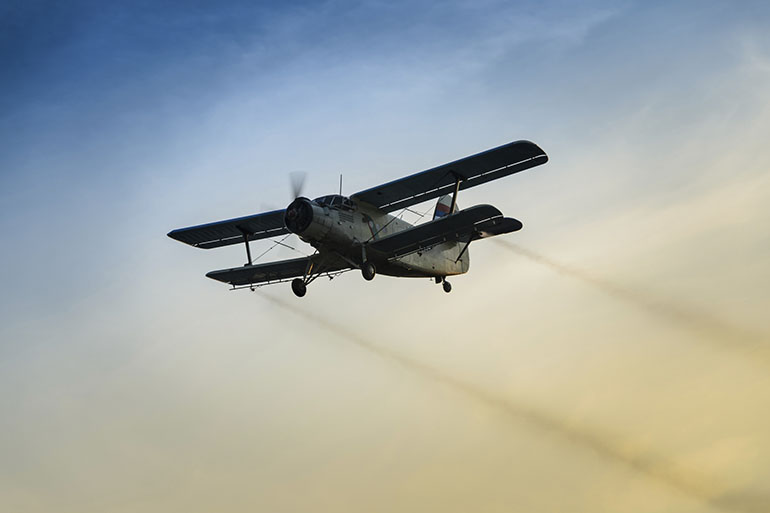This story has been updated and was first published on Aug. 29.
The aerial-spraying campaign against Zika-carrying mosquitoes continues in two Florida counties this week, and if the blitz succeeds as the Centers for Disease Control and Prevention hopes, it could be one for the record books.
Scant published research exists to prove aerial spraying works against the adult Aedes aegypti mosquitoes that carry Zika. Many experts in tropical diseases dismiss insecticide spraying from low-flying planes because they say the urban dwelling species may escape the killer spray by living indoors.
CDC Director Dr. Tom Frieden refuted skeptics recently when he told reporters that Miami-Dade’s aerial spraying of the insecticide naled — in a fine mist fired from planes about 100 feet off the ground — had been found to consistently kill more than 90 percent of Aedes aegypti in traps.
Spraying started Aug. 4 in a 10-square-mile area in Miami-Dade’s Wynwood area, where the first locally transmitted cases of Zika in the continental U.S. have been found. After a contentious city commissioners meeting last week, Miami Beach moved forward with its own plan to spray naled at the CDC’s recommendation, despite the agency’s earlier concerns that coastal wind and the city’s high-rises would render the action ineffective. The first flights took place on Friday. Aerial spraying also kicked off this week in Broward County, north of Miami.
Other than the data gathered in Wynwood, the CDC has so far cited just one source in support of its airborne battle plan to wipe out large numbers of adult mosquitoes quickly: unpublished research by a rookie mosquito control specialist.
That’s where the New Orleans Mosquito, Termite and Rodent Control Board comes in.
In a recent article for the influential medical journal JAMA, Frieden wrote that in New Orleans, planes spraying ultra-low volumes of insecticide reduced caged Aedes aegypti mosquitoes in open and sheltered areas by more than 90 percent.
His source for that data: a non-peer-reviewed presentation by a specialist named Brendan Carter at the New Orleans mosquito control board. Some of the presentation’s research was conducted while Carter was still an intern there in 2014, according to his LinkedIn profile.
The board hired him that September after his internship. Carter earned his master’s degree in 2014 from the Tulane University School of Public Health and Tropical Medicine, his LinkedIn page also shows.
Even so, other experts in mosquito-borne diseases were unconvinced when asked about Carter’s finding as described in Frieden’s commentary for JAMA.
“I know of no published reports that support this figure,” said Durland Fish, a Yale University professor emeritus of microbial diseases as well as a professor of forestry and environmental studies there. Fish worked with public officials in Dominica in 2014 to counter chikungunya virus, another disease spread by the Aedes aegypti mosquito.
“This is a domestic mosquito, meaning they live inside the house — in closets, under the bed, in the sink. Spraying outside won’t be very effective,” he said.
A CDC spokeswoman said the agency carefully reviewed the New Orleans data and was “confident it was a good indicator of efficacy.” Frieden cited it in JAMA because “there is limited published peer-reviewed data on efficacy of ultra-low volume aerial spraying of naled against Aedes aegypti,” according to the agency.
Carter said he plans to submit the research for peer review and publication but does not yet know where.
Health officials have said there has been progress in the two square mile area that is also being sprayed with a pesticide that kills mosquito eggs and larvae. But in areas treated with naled alone, “the adult populations are rebounding much quicker and much higher,” Janet McAllister, the CDC entomologist advising the county, told the Miami Herald.
McAllister advised the New Orleans mosquito control board on the research that the CDC cited to justify aerial spraying, according to the board’s director, Claudia Riegel.
“She offered advice on the proper protocol. What are the best practices? We want to be able to compare our results with other mosquito control districts across the country,” Riegel said.
At the recommendation of the CDC, the Miami-Dade Mosquito Control launched aerial spraying in Miami Beach two weeks after the spraying in Wynwood ended on Aug 27. In response to vociferous public opposition, city commissioners met on Sept. 7 to express concern about the potential for unintended health effects. Protesters marched outside and heckled Miami-Dade County Mayor Carlos Gimenez.
The Environmental Protection Agency says naled poses no health risk. But that hasn’t satisfied critics, who point out naled belongs to a potent class of chemicals called organophosphates and is banned in Europe. Even some public officials expressed worry.
“I am not comfortable with it, but I think it’s important that we listen to the proper scientific and medical authorities and what they recommend,” Miami Beach Mayor Philip Levine told NBC.
Leigh Bowman, an epidemiologist at the Liverpool School of Tropical Medicine in the U.K., reviewed hundreds of research papers on the transmission of dengue fever, another tropical disease spread by the Aedes aegypti, but could not find any controlled studies on aerial spraying.
“There is very little strong scientific evidence to support aerial spraying as an effective intervention against Aedes mosquitoes,” Bowman said.
Research supports insect spraying to halt the spread of diseases such as sleeping sickness, which is transmitted by the tsetse fly. But Aedes aegypti “can complete their entire life cycle — breed, feed, rest, reproduce — within homes, where insecticides are unlikely to penetrate,” he said.
“Given this behavior — almost exclusive propensity to feed on humans, rest within their homes and tendency to travel less than 250 meters in search of a blood meal — it may be that aerial spraying could be largely ineffective,” Bowman said.
That sort of skepticism is outdated, according to Joseph Conlon, a spokesman for the American Mosquito Control Association and a retired U.S. Navy entomologist.
“That has been the dogma over the years, but the techniques have improved immensely,” he said.
The airplanes flying over Florida are spraying naled in a fine mist with droplets 10 million times smaller than the size of a BB gun pellet, which are capable of wafting into homes through screen doors and bathroom vents, Conlon said. He also suggested that Miami’s Aedes aegypti mosquitoes are more likely to be found outside than Aedes aegypti found elsewhere.
Frieden wrote in JAMA that “further evaluation of efficacy of aerial applications” is needed, and that it “may be the only feasible method to reach large urban populations at the speed and scale required to ablate sudden outbreaks.”
As new clusters of locally-transmitted Zika have surfaced in Pinellas County and Palm Beach County, the CDC could explore aerial spraying to curtail outbreaks of the virus in other locations.
Miami-Dade County conducted another aerial spraying for mosquito larvae on Aug. 27, but no further rounds are scheduled for adult mosquitoes “at this time,” a spokeswoman said.
A CDC spokeswoman said that further evaluation will include examining data from state and local health departments together with local mosquito control districts. She referred to two studies showing effective control of Aedes aegypti with an ultra-low volume application of the insecticide malathion during dengue outbreaks. One study was published in the Journal of the Medical Association of Thailand by researchers in Indonesia in 1977 and another published in the Journal of the American Mosquito Control Association by the New Orleans mosquito control board in 1987.
“The data that will come out from Miami-Dade County may provide more evidence once it is collected,” she said.








